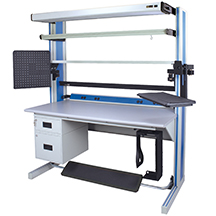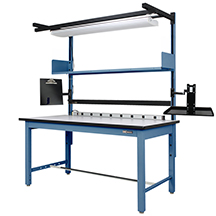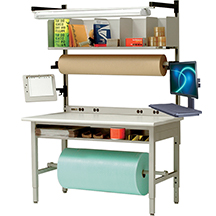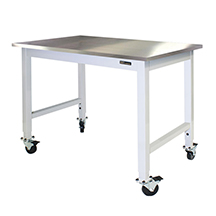Surface Inspection Saves Costs for Cutler-Hammer de Puerto Rico
Key elements of being a good Sales Application Manager (SAM) AKA Specifying Specialist, are effectively listening to your customer, paying attention to detail and the ability to plan ahead. However, when specifying an assembly line for a new project based solely on prototype production, sometimes all the planning in the world will result in going back to the drawing board. Such was the case for Gary Cowham (IAC SAM), during the proposal stages of a bid for Cutler-Hammer.
Cutler-Hammer, worldwide manufacturers of electronics, circuit breakers, and power supplies, came to IAC, a Divsion of Treston, for workstations for the Assembly division of their Puerto Rico plant. Ariel Guzman of the Cutler-Hammer de Puerto Rico Company was put in charge of a new product line being sent from Wisconsin to Puerto Rico for manufacturing. After visiting their Eaton facility in Wisconsin, Guzman approached Arnoldo Acosta of Electronic Sales to help him design work cells for manufacturing his prototype.
Guzman was looking for inline benches for progressive assembly of a power supply unit. His primary requirement was fi nding a way to rotate the product on the line because the unit required assembly on both sides. Each unit weighed 75lbs. before crating and would weigh 1110lbs. when completed. A solution for transporting the units from Assembly to Packaging was also required due to the substantial weight of the product. Guzman had viewed a similar application using ball transfers while visiting their Wisconsin facility, so he asked IAC for the same type of benches. Acosta brought this requirement to Gary Cowham of IAC for application assistance. Luckily Cowham had a little forethought that went a long way when specifying the project. Cowham and the IAC team prevented a costly installation of workstations that wouldn’t work for this particular assembly. After receiving the units’ base for ball transfer calculations, John Notti, IAC’s Director of Operations and Engineering, determined the irregular surface of the product would get hung up on the balls. Notti decided to draw up a second set of bench drawings that substituted Omtec rollers and built-in turntables in place of the ball transfer system. Adjustable overhead tool trolleys, part cup rails, shelving, lights and electrical were also included. The problem of packing the rather large and heavy units at completion of assembly was addressed by creating an inset packaging area. IAC designed a special manually adjustable 18” deep inset work surface that open crates are put into. Instead of being 4 feet above the fl oor (with a 30” tall work surface), the inset packaging area allows the 18” tall crates to be recessed enough to fasten the top of the crates at sitting level without reaching. The crates are then picked up with a small forklift and sent to shipping.
When asked why IAC took the time to do a second proposal instead of just supplying what the customer ordered, Cowham replied, “Our job isn’t just to sell product. It’s to ensure the customer gets the right bench for the application.” “I knew an overseas application would require careful planning to get it right,” said Cowham. “When a product is designed in the US for manufacturing overseas a lot of time typically goes into the whistles and bells of the prototype without a lot of consideration for how 20-30 of them will be built in a day,” explained Cowham. ”That’s where IAC comes in,” said Cowham. “We solve application problems for our customers through the joint efforts of knowledgeable representatives, in-house engineering and sales application support.”
 Buy Online Now!
Buy Online Now!
 Buy Online Now!
Buy Online Now!











